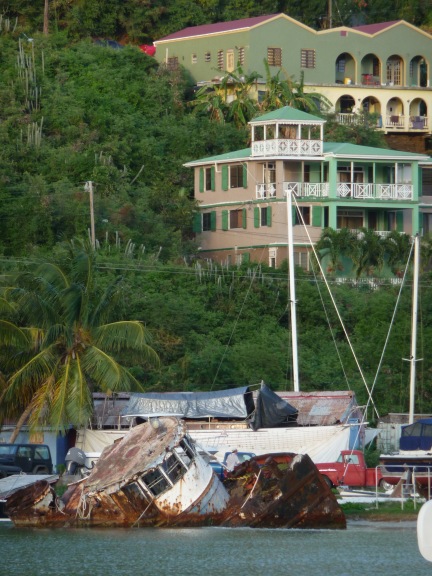I’m one of those atheists who love Christmas, but I knew I wouldn’t be in the mood this year. With my mother’s death a few months ago, my side of the family had lost the magnet that brought most of us together on the holidays. My wife has also become parentless, so we reluctantly decided to give up tamales, posole, and the Canyon Road farolito walk for a few days in neverland.

West End, Tortola
We’d flown from Albuquerque to Charlotte Amalie in the U. S. Virgin Islands and spent a few hours wandering around Emancipation Park, where a Christmas tree stood among palms hung with ornaments and lights. Majorettes in skimpy red and green costumes twirled batons while calypso musicians prepared for a performance on the bandstand. In front of the old post office, the Rising Stars Youth Steel Orchestra hammered the air with melodies, and escapees from a cruise ship bought duty-free jewelry and rum.
From Charlotte Amalie it was a short ferry ride to Tortola where hills green with mahogany and white cedar surrounded the harbor. Mansions as big as any in the Santa Fe foothills had been chopped into the steep slopes. (No sign of an escarpment ordinance here.) A recent construction project, we were told, had set off a landslide. You could barely see the scar anymore. Things grow so quickly in the tropics.
And yet there is a water problem. With only a few seasonal streams and no significant aquifer, rainwater must be collected in cisterns. But that is hardly enough. Tortola’s public drinking water comes from desalination factories run by corporations that sell the output to the government for as much as 1.6 cents a gallon — approximately triple what we pay in Santa Fe.
With only 23,000 residents on the island, most of the water is absorbed by the hundreds of thousands of visitors who pass by each year. They also produce most of the garbage. For $2 a bag it is collected at the marina and hauled a few miles down shore to a huge incinerator, which converts as much as 90 tons a day into smoke. (After complaints from a neighboring island, the local government agreed to install smokestack scrubbers and to separate out the tires and oil before burning.) Next to the incinerator, the island’s electricity is produced by a diesel-fired generating plant. And next to that is a gravel quarry.
At Soper’s Hole the infrastructure of industrial tourism is hidden from view. Walking along the wharf with its open-air restaurants and air-conditioned boutiques, one might as well be in Newport Beach or the Hamptons. People don’t come here to see the islands, except from across the water.
It was time to set sail. With little idea of what to expect, I apprehensively took a place on deck as we departed for Drake’s Channel and four days in an expensively maintained paradise.
George Johnson
The Santa Fe Review
